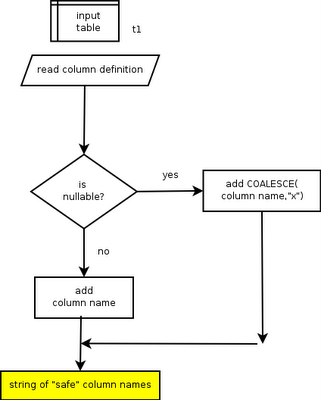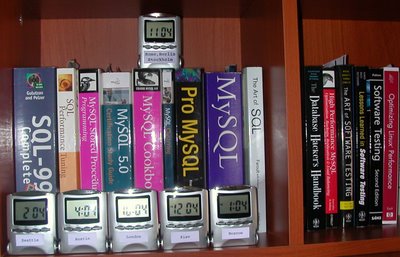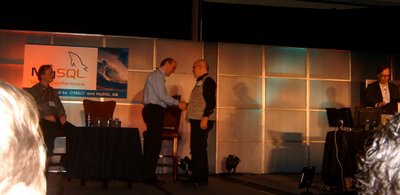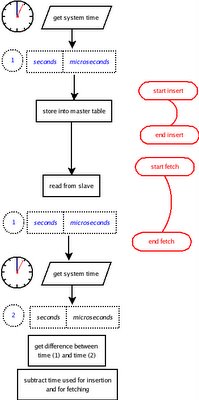This is the first tutorial of a series dedicated to testing techniques.
Soon all this material will find a home in a more appropriate place. In the meantime, enjoy the lecture!
While testing large tables, it is useful to test if two tables have the same contents. For example, if you want to compare performance between two tables using different storage engines, or tables created on different filesystems, you must be sure that both tables have the same content. Having loaded both from the same source is not a guarantee that the contents are the same: a mistake or different SQL modes used during the load may result in substantial differences.
General concepts
Then, you need to compare two, possibly very large tables. There are several methods available. One is to run a query with a LEFT OUTER JOIN. However, this method is likely to take very long or even exhaust your system resources if your tables are really large.
One method that I have been advocating for long time is to run a global CRC on both tables and then compare the results.
And, I hear you asking, how do you get a global table CRC?
There is no predefined SQL feature for this task. Recent MyISAM tables have a built-in CRC, but you can't get it from a SELECT statement, and besides, if you need to compare the contents of such a table with one using a different engine, you are out of luck. Then, we need to use something more general, which can be applied to any table.
The first step to get a global CRC is to get a list of the columns that we can then pass to a CRC function such as SHA1 or MD5.

This list is a string made of the name of the columns, which we will pass to a CONCAT_WS function. However, if you know how SQL functions work, you will know that any NULL value in the list will nullify the whole expression. Therefore, we need to make sure that every nullable column is properly handled by a COALESCE function. The result of this operation, which we delegate to a stored function, is a safe list of column.
The second step towards a global table CRC is to calculate a CRC for each record. We use the above list of columns to create a SELECT statement returning a SHA1 for each record in the table. But, what to do with it? There is no aggregate SQL function available for SHA or MD5. Thus, we need to process the result and calculate our CRC manually.
As noted in
a previous post, we can do that in two ways, using cursors or using a blackhole table. Some benchmarks show that the blackhole table is much faster than the cursor, and this is what we do.

We start with an empty CRC. For each row, we compute a CRC of the whole record, plus the existing CRC. Since we are using a SELECT statement, we need to get rid of the output, because we are only interested in the calculation stored in the user variable. For this purpose, a black hole table is very well suited. At the end of the SELECT + INSERT operation, we have in hand two variables, one showing the count and one holding the global CRC for the table.
Repeating this process for the second table we need to compare, we can then compare two simple values, and determine at a glance if we are dealing with comparable data sets.
Implementation
Let's put the concepts together with a few stored routines.
delimiter //
drop function if exists get_safe_column_list //
create function get_safe_column_list
(
p_db_name varchar(50),
p_table_name varchar(50),
p_null_text varchar(20)
)
returns varchar(10000)
reads sql data
begin
if ( @@group_concat_max_len < 10000 ) then
set group_concat_max_len = 10000;
end if;
return (
select
group_concat( if(is_nullable = 'no', column_name,
concat("COALESCE(",column_name, ", '", p_null_text,"')") ))
from
information_schema.columns
where
table_schema= p_db_name
and
table_name = p_table_name
);
end //
The first function returns a safe list of column names.
drop function if exists get_primary_key //
create function get_primary_key (
p_db_name varchar(50),
p_table_name varchar(50)
)
returns varchar(10000)
begin
if ( @@group_concat_max_len < 10000 ) then
set group_concat_max_len = 10000;
end if;
return (
select
group_concat(column_name order by ORDINAL_POSITION)
from information_schema.KEY_COLUMN_USAGE
where
table_schema=p_db_name
and table_name = p_table_name
and constraint_name = 'PRIMARY' );
end //
The second routine returns a table primary key, as a list of column.
drop procedure if exists table_crc //
create procedure table_crc (
IN p_db_name varchar(50),
IN p_table_name varchar(50),
OUT p_table_crc varchar(100)
)
reads sql data
main_table_crc:
begin
declare pk varchar(1000);
declare column_list varchar(10000);
set pk = get_primary_key(p_db_name, p_table_name);
set column_list = get_safe_column_list(p_db_name, p_table_name, 'NULL');
if (column_list is null) then
set p_table_crc = null;
leave main_table_crc;
end if;
set @q = concat(
'INSERT INTO bh SELECT @tcnt := @tcnt + 1, ',
'@tcrc := SHA1(CONCAT(@tcrc, CONCAT_WS("#",', column_list, ')))',
' FROM ', p_db_name, '.', p_table_name,
if (pk is null, '', concat(' ORDER BY ', pk))
);
drop table if exists bh;
create table bh (counter int, tcrc varchar(50)) engine = blackhole;
set @tcrc= '';
set @tcnt= 0;
prepare q from @q;
execute q;
set p_table_crc = concat(@tcnt,'-',@tcrc);
deallocate prepare q;
end //
The third procedure returns the global CRC of a given table.
drop procedure if exists table_compare //
create procedure table_compare (
IN p_db_name1 varchar(50),
IN p_table_name1 varchar(50),
IN p_db_name2 varchar(50),
IN p_table_name2 varchar(50),
OUT same_contents boolean
)
begin
declare crc1 varchar(100);
declare crc2 varchar(100);
call table_crc(p_db_name1,p_table_name1, crc1);
call table_crc(p_db_name2,p_table_name2, crc2);
select concat(p_db_name1, '.', p_table_name1) as table_name, crc1 as crc
union
select concat(p_db_name2, '.', p_table_name2) as table_name, crc2 as crc ;
set same_contents = (crc1 = crc2);
select crc1=crc2 as 'same contents';
end //
delimiter ;
The final routine puts all pieces together, returning a boolean value telling if the two tables have the same contents.
Testing
After loading the above code in our database, we can call a "table_crc" procedure to get our coveted value. Let's take the famous world database and let's give it a try.
mysql> use world;
Database changed
mysql> create table City2 like City;
Query OK, 0 rows affected (0.03 sec)
mysql> alter table City2 ENGINE = InnoDB;
Query OK, 0 rows affected (0.09 sec)
Records: 0 Duplicates: 0 Warnings: 0
mysql> insert into City2 select * from City order by District, population;
Query OK, 4079 rows affected (0.33 sec)
Records: 4079 Duplicates: 0 Warnings: 0
First of all, we create another table, with the same structure of City, but using a different engine, and storing data in a bizarre order to see if our routine is robust enough. In fact our routine will calculate the CRC after sorting the data by primary key, so that there won't be any surprise.
mysql> call table_crc(schema(), 'City', @city_crc);
Query OK, 0 rows affected, 1 warning (0.16 sec)
mysql> select @city_crc;
+-----------------------------------------------+
| @city_crc |
+-----------------------------------------------+
| 4079-407840fbf812b81eee55d3a438cf953f81c63bc0 |
+-----------------------------------------------+
1 row in set (0.00 sec)
mysql> call table_crc(schema(), 'City2', @city2_crc);
Query OK, 0 rows affected (0.13 sec)
mysql> select @city2_crc;
+-----------------------------------------------+
| @city2_crc |
+-----------------------------------------------+
| 4079-407840fbf812b81eee55d3a438cf953f81c63bc0 |
+-----------------------------------------------+
1 row in set (0.01 sec)
When we compare the CRC, we can easily see that the two tables are the same. If all these statements are tedious to write, we can use a shortcut:
mysql> call table_compare(schema(), 'City',schema(), 'City2', @same);
+-------------+-----------------------------------------------+
| table_name | crc |
+-------------+-----------------------------------------------+
| world.City | 4079-407840fbf812b81eee55d3a438cf953f81c63bc0 |
| world.City2 | 4079-407840fbf812b81eee55d3a438cf953f81c63bc0 |
+-------------+-----------------------------------------------+
2 rows in set (0.24 sec)
+---------------+
| same contents |
+---------------+
| 1 |
+---------------+
1 row in set (0.24 sec)
Le'ts make it fail, to see if it is true:
mysql> update City2 set population = population + 1 where id = 1;
Query OK, 1 row affected (0.05 sec)
Rows matched: 1 Changed: 1 Warnings: 0
Now the two tables will have at least one difference:
mysql> call table_compare(schema(), 'City',schema(), 'City2', @same);
+-------------+-----------------------------------------------+
| table_name | crc |
+-------------+-----------------------------------------------+
| world.City | 4079-407840fbf812b81eee55d3a438cf953f81c63bc0 |
| world.City2 | 4079-b3b613b20570024be727ef0454053a96cfc36633 |
+-------------+-----------------------------------------------+
2 rows in set (0.23 sec)
+---------------+
| same contents |
+---------------+
| 0 |
+---------------+
1 row in set (0.23 sec)
And our routine finds it. QED.















